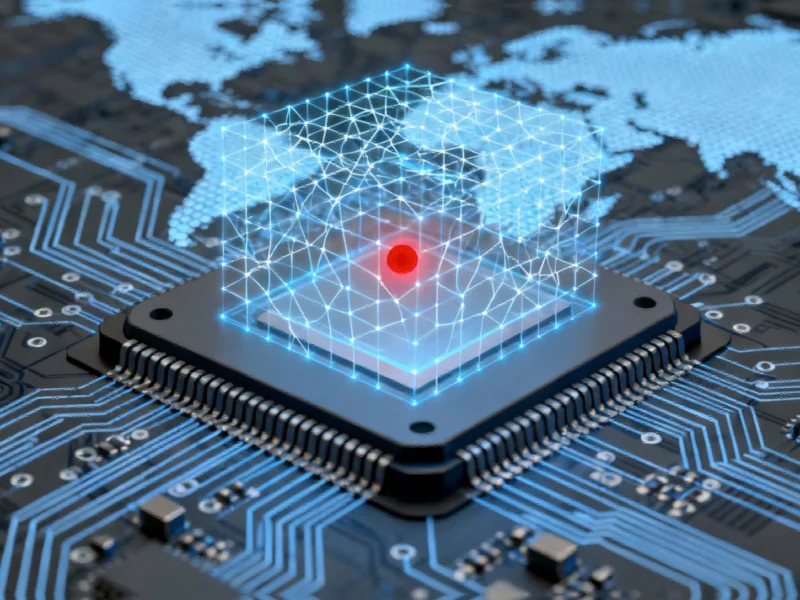Revolutionary AI System Transforms Hardware Security Landscape
In a significant advancement for hardware security, researchers at the University of Missouri have developed an AI-powered system that detects malicious chip modifications with unprecedented 97% accuracy. This breakthrough comes at a critical time when global supply chain vulnerabilities have made hardware trojans a growing concern across industries. The timing of this development is particularly relevant as European cyber defense faces increasing pressure from sophisticated threats targeting critical infrastructure.
The Hidden Threat in Modern Electronics
Hardware trojans represent one of the most insidious threats in today’s interconnected digital ecosystem. These malicious alterations are deliberately inserted during chip manufacturing and can lie dormant for extended periods before activation. The consequences can be devastating – from compromised medical equipment and financial systems to critical defense infrastructure failures. The challenge is compounded by the distributed nature of modern chip production, where design, testing, and assembly often involve multiple companies across different countries.
As industry veterans shift their investment strategies toward more secure technologies, the need for robust hardware security solutions becomes increasingly apparent. The global semiconductor supply chain’s complexity creates numerous insertion points for trojans, making traditional detection methods insufficient against sophisticated attacks.
PEARL: A New Approach to Hardware Security
The University of Missouri team introduced PEARL (Pattern Extraction and Recognition for Logic), which leverages multiple large language models including GPT-3.5 Turbo, Gemini 1.5 Pro, Llama 3.1, and DeepSeek-V2. What sets this system apart is its use of in-context learning techniques that require no training from scratch. The system employs zero-shot, one-shot, and few-shot strategies to identify trojans in Verilog code with remarkable efficiency.
This technological advancement aligns with broader industry trends, as evidenced by major acquisitions in the digital asset security space that highlight growing concerns about system integrity. PEARL’s ability to operate without a “golden model” – traditionally a clean reference chip used for comparison – significantly expands its practical applications across different manufacturing environments.
Performance Metrics and Real-World Implications
Experimental results using established chip benchmarks, including Trust-Hub and ISCAS 85/89 datasets, demonstrate PEARL’s exceptional capabilities. Enterprise-grade LLMs like GPT-3.5 Turbo achieved the highest accuracy at 97%, while open-source alternatives such as DeepSeek-V2 reached approximately 91%. The system not only identifies potential threats but also provides human-readable explanations for its classifications, enhancing transparency and trust in the detection process.
The importance of such security measures is underscored by recent incidents where thousands of government credentials were compromised, highlighting the cascading effects of security vulnerabilities. In hardware security, the stakes are even higher, as compromised chips can undermine entire systems from the ground up.
Limitations and the Path Forward
Despite the impressive 97% detection rate, researchers acknowledge that perfect security remains elusive. The 3% margin for undetected trojans represents a significant risk in high-stakes environments where single failures can have catastrophic consequences. This reality necessitates multi-layered security approaches that combine AI detection with manual verification and comprehensive testing protocols.
The ongoing evolution of delivery and logistics systems, including autonomous delivery partnerships between major tech companies, demonstrates how hardware security intersects with emerging technologies. Similarly, as new social platforms emerge to address digital wellbeing, the underlying hardware security becomes fundamental to user trust and platform reliability.
Industry Impact and Future Applications
The PEARL system represents a paradigm shift in how the industry approaches hardware security. By leveraging advanced AI capabilities, organizations can now detect threats that would have previously gone unnoticed until activation. This proactive approach could significantly reduce the financial and reputational damage associated with hardware recalls and security breaches.
As European cyber defense systems face unprecedented challenges, technologies like PEARL could play a crucial role in securing critical infrastructure. The researchers emphasize that while their system marks substantial progress, the ultimate goal remains developing comprehensive security frameworks that address vulnerabilities throughout the entire hardware lifecycle.
The integration of AI-driven detection systems into standard manufacturing and quality assurance processes could fundamentally transform how we secure the digital infrastructure that underpins modern society. As hardware becomes increasingly complex and supply chains more globalized, such innovations become not just advantageous but essential for maintaining trust in our technological ecosystem.
Based on reporting by {‘uri’: ‘techradar.com’, ‘dataType’: ‘news’, ‘title’: ‘TechRadar’, ‘description’: ”, ‘location’: {‘type’: ‘country’, ‘geoNamesId’: ‘2635167’, ‘label’: {‘eng’: ‘United Kingdom’}, ‘population’: 62348447, ‘lat’: 54.75844, ‘long’: -2.69531, ‘area’: 244820, ‘continent’: ‘Europe’}, ‘locationValidated’: False, ‘ranking’: {‘importanceRank’: 159709, ‘alexaGlobalRank’: 1056, ‘alexaCountryRank’: 619}}. This article aggregates information from publicly available sources. All trademarks and copyrights belong to their respective owners.



